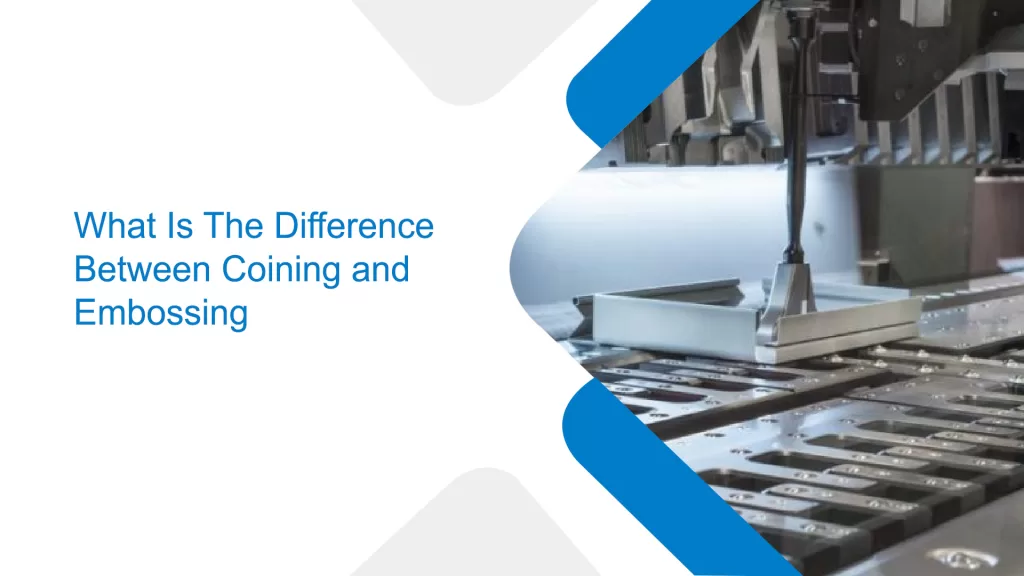Metal Stamping
06 Jul 2025
What Is The Difference Between Coining and Embossing
Coining and embossing are two of the primary stamping methods. These processes create complex shapes with extremely precise tolerances. The two processes may sound similar regarding the difference between coining and embossing, but you should understand how they differ. Knowing how both processes vary and where they are used often is wise. In this post, you will learn how coining and embossing differ.
What Is Coining?
Coining is a metalworking technique that adds delicate and detailed embellishments to a workpiece's surface. After performing this cold and lubrication-free precision forging procedure, you can expect the maximum level of accuracy. High stress during coining will cause the metal to reshape in the die permanently. In contrast to conventional stamping, Coining displaces material rather than removes it. The coining operation makes coins and jewelry, as they require good accuracy. It is very helpful for providing excellent surface finishes for small, intricate objects.
What Is Embossing?
Embossing is a metal shaping technique that produces raised or sunken surfaces by pressing patterns or designs into sheet metal. The metal will be passed between two identical male and female roller dies to do this. Embossing is cool because it reshapes metal to create textures or designs without compromising thickness. Various dies may produce multiple designs, including stucco and more. Aluminium and zinc are some of the famous metals among the metals it can operate with Coining requires more effort than embossing, which makes embossing smoother. It can be found on metal sheets for architectural projects, jewelry, and ornamental objects. It's a clean, accurate method that adds a beautiful surface to metal sheets without making them thinner.
Key Differences Between Coining and Embossing
Now that you have understood the basic descriptions of both coining and embossing, here are some points to help you know the difference between coining and embossing in a simpler way
Pressure and Force
Coining
- The process of coining produces a highly detailed and high-relief design by applying a lot of pressure to push the metal into the die's shape.
- Understand that Coining requires a lot more force than embossing.
Embossing
- Compared to coining, embossing requires less pressure.
- Without substantially changing the material's thickness, a raised or recessed design will be produced by applying force more subtly.
Impact On Metal Thickness
Coining
- The enormous force used during the operation results in a considerable variance in the thickness of the metal
- The flow of the metal during coining may cause the workpiece to grow somewhat thicker or thinner.
Embossing
- Embossing produces patterns without compromising the metal's thickness.
- Instead of the overall structure of the material, the effect is mostly on the surface texture or design.
Design Complexity
Coining
- Coining is such a perfect option for making elaborate and incredibly complex designs.
- Coins and tiny precision pieces are among the many applications frequently used since they call for fine and accurate details.
Embossing
- A few examples of patterns and textures that can be created through embossing are
Wood grain and leather
- Although it is not as intricate as coining, it is perfect for designs that need wide patterns or logos.
Flow Direction Of Material
Coining
- The metal flows perpendicular to the applied force when coining.
- This indicates that the direction of the metal's movement helps create accurate and highly detailed designs.
Embossing
- Embossing flows in the direction of the applied force.
- Thus, the metal can develop raised patterns or textures on its surface.
Applications
Coining
- This method is used in fields including medal production and jewellery manufacture that require complicated details
- It is also used to produce extremely accurate components for aerospace and electronics.
Embossing
- Creating textures and patterns on items like nameplates and decorative panels is where embossing is most frequently used.
- It's also used to create things like branding marks and jewelry shapes.
Production Volume And Cost
Coining
- Coining is typically used for short production runs or applications demanding great precision because it involves a lot of force and specialised equipment.
- This is why the cost will be quite high.
Embossing
- Embossing is frequently used for medium to high-volume production runs because it is more economical
- This procedure is tailor-made for products that require uniform surface textures or patterns
Key Takeaway
- Metal goods appear better and function better when coined or embossed
- What the project requires will determine which one to use
- Although coining requires more force and is more expensive, it works best when you need extremely fine and detailed drawings
- When creating a large quantity of objects or when maintaining a consistent metal thickness, embossing works best for simple patterns or textures.
The Final Words
With the above points, the difference between coining and embossing can be understood more easily. If you're interested in learning how precision metal components are manufactured in real industries, Eigen Engineering is a company that does just that. We provide premium stamped parts for automobiles, aircraft, electronics, and other applications. Eigen manages everything, including plastic moulding, metal stamping, tooling, and plating. To bring your designs to life, get in contact with Eigen Engineering right now!
